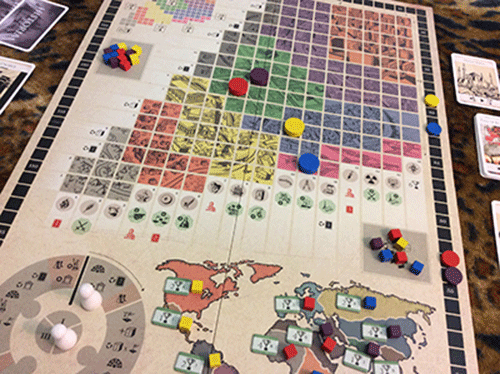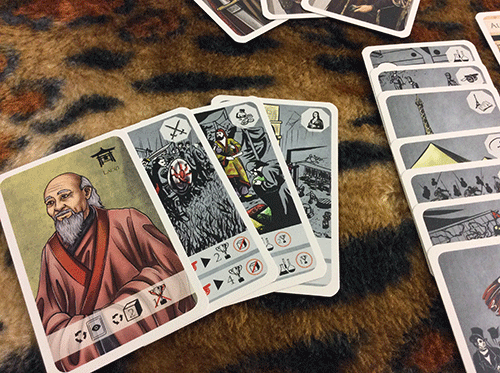Historia Review
on May 12, 2016

Michael: 
MB: Byron, I think you and I are going to look at Marco Pranzo’s Historia and come up with a similar conclusion. This is a very competent, highly refined civilization game that hits all of the right notes – progressive advantages, exploitation of resources, a broad sense of scope and geographical relationships between groups that include factors such as trade and warfare. That’s all a very clinical way to define what makes a Civ game, but it’s appropriate because this is probably the most clinical take on the genre I’ve ever seen. On one hand, it’s a smart design that reduces all of the above into a simple system driven by a grid, a tiny map, a handful of cubes and some action cards. On the other, it comes across as soulless.
BC: “Soulless†is absolutely right. In fact, I wouldn't go so far as to say that it “reduces all of the above†into its systems, rather that it uses a few interesting but themeless systems and pretends they represent technological upgrades, war, trade, and exploitation.

MB: I like how you put that- it’s pretending to represent all of this stuff. But I’m going to do a little jog-around and disagree with you somewhat. I don’t think this game is themeless at all and in fact it captures all of the core civ game themes. The problem is that it just doesn’t quite bring them home conceptually because the mechanics aren’t contextual enough. There’s not even really any nomenclature to distinguish the technology advances, just icons.
BC: That's my biggest problem with the development matrix, probably the most unique and blatantly misleading mechanism. When players increase their civ's military or technology, they move up or to the right along its axes. The rows represent military, the columns represent tech, and big blotchy areas of the grid are supposed to represent different systems of government. There are pictures along the bottom representing the different tech advancements you progress through (every civ does the same ones in the same order), but only 3 or 4 of those actually have any impact on the game; the rest are just pictures. It might as well be a grid representing the price and quantity of wheat.
MB: That’s right, a lot of the advances are just icons and in many instances the actual progress is either just being able to attack or raid a lower military player or trade with one that has a higher technology. I do like how Pranzo has come with this sort of mutually limiting system that channels development into tech or military (that is also impacted by geographic expansion and other factors), but there’s very little excitement or sense of historical narrative like there is in a game such as Clash of Cultures, the gold standard for this genre.
BC: That lack of nomenclature you mentioned earlier actually creates a few problems, such as when a rule refers to “Navigation†and you have to make a blind guess as to which icon they're talking about. The grid is also conspicuously empty. It's got an aesthetically pleasing shape to it, but functionally, it could have just been two parallel tracks; there's virtually no interaction between the x and y axis. Every so often, if you're skirting the edge, you might hit a bump where you can't increase tech any more until you build up your military, or vice versa, but that's the extent of it. There are a couple of promo expansions that take better advantage of the development matrix by adding bonus tokens or roadblocks to spaces in the middle of the grid. I wish something like that had been included in the base game.
MB: But that is really, really gamey to have “bonus†tokens at certain points. It’s also kind of weird to me how progress is keyed to these kind of unlocks, which make certain tiers an objective – you get to do an “improved†version of an action, draw a leader card, gain a cube, that kind of thing. If the grid had branches, you would get more of a sense of civilizations developing along different lines and with different strategies but you kind of just keep going in these two directions. Maybe that’s part of the problem here, the development is bilinear rather than based on a more traditional branching tree structure with optional prerequisites and discounts, and that takes away the sense of agency that should come with steering a civilization to glory. Maybe that is the “soul†we are looking for?
BC: I think it's more a problem of missed expectations. You see a civ game, and you expect more customization options than “higher or farther right?†The selection of action cards—every player gets the same 10—also seems limiting at first, but it's actually here where you make all the important choices that go into steering your civ. I love the hand management at play here. When you play a civ action, it goes into a “discard queue,†and when you play the Revolution card (signaling the end of the round), you get to take one card of your choice back into hand. Aside from this, you typically recover used cards slowly, in a first-in, first-out format, so getting an action back right away is a big deal, allowing you to nudge your culture in a more specialized direction.
MB: The card play presents some interesting sequence puzzles, for sure. How to cycle cards back into your hand, how to exploit opportunities to get them back ahead of schedule so to speak, and a lot of the game is really in tactically sorting out the order you want to do things and then thinking strategically about what you can do to fix the queue. I think the card-based action selection works and I think that in those ten cards you get a good sense of “civilization actionsâ€. I also like how advances enhance those actions, specifically.
But there is something that bugs me about the cards, and it has to do with the Civbots- optional “dummy†players you can use to fill empty seats all the way down to a solo game. The Civbots draw from a random assortment of special action cards. So this kind of makes me wonder how much game is really here when 3-4 random card draws generate a competitive opponent. Granted, the AI doesn’t have to contend with the economy but they can beat you with random sequencing.

I'm not convinced the civbots are an accurate indicator of the game's depth. They follow the standard AI pattern of "stupid but strong," which works well enough to give some friction to the game, though their military gets stupidly powerful very quickly if you use the harder AI levels.
MB: Mechanically it makes sense, I get the whole “bigger empire=harder to manage†but it also sort of doesn’t make sense. Whoops! We conquered the entire Asian continent, now we can’t really do much until the next age. It’s a very restrictive system, and in general I like that it works on a similar in play/out of play cycle as the cards, but I think using them as geographical markers of ownership is a little off. I mean, you can map the rationale out for it pretty easily. For example, in the early game it makes sense that you sort of either use the cubes to develop technologies, infrastructure and so forth or expand territory. But later on the game, it all comes across as another gear grinding in a machine full of them.
I’m glad that the geography is there and that there is a sense of “placeâ€- and it handles it in a minimalist way that is really pretty smart given the epochal scope of the game as a whole.
BC: I think we're agreed that Historia, in trying to be elegant, strips away the heart and soul of a civ game. Luckily, you can add a little of that back in with the optional modules, Leaders and Events. Having played a few games with these, I can't see myself ever going back to the vanilla game. Leaders gives you short-term goals: at the end of every era, you score extra points if your civ is the frontrunner in certain categories, like most Wonders or highest tech. Events add a special rule to each round, either positive or negative. For instance, you might face the Black Death and have to drop a tech level with every action you take, be able to pick up Wonders by conquering during the Crusades, or you might recover some Power Cubes each time you raise your military with the Conscription event. What makes these work for me is that the Events deck is face up, so you can always see the next event coming up and play out the current turn accordingly. It adds a narrative and sense of variety the game sorely needs.
BC: I love the power cube economy. In general, you want to conquer a lot of territory on the teensy tiny world map so you can score big points at the end of each of the 3 eras. But spreading your cubes all over the map leaves you with no cubes to fuel actions like developing tech/military or buying wonders. When an opponent wages war on you, removing your cube from a disputed territory, they're actually doing you a favor, in a way. This helps keep the military strategy from becoming too dominant, excuse the pun. It's a simple but meaningful representation of one of the great problems in world history: the bigger your empire spreads, the harder it is to manage. (Ask the Mongols.)

 Customer Support
Customer Support  Subscribe
Subscribe 




 Account
Account  Wishlist
Wishlist 

